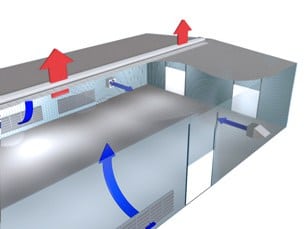Buoyancy Ventilation and You
What is Buoyancy Driven ventilation?

Buoyancy ventilation results from the density differences between interior and exterior air. This variance causes the warm air to rise above the chilly air and create an upward airstream. The effectiveness of the buoyancy effect increases as the temperature differences between the different sections of the building increases. Increased height between the lower and higher apertures, leads to better displacement and superior ventilation.
When a building has both an exhaust opening (a natural ventilator) and an intake opening (a wall louver), the building’s neutral plane is established at a point in-between the two. This is the point at which the internal pressure is the same as the external pressure. Above the neutral plane, the air pressure is positive, and air flows out of the rooftop aperture. Below the neutral plane, the air pressure is negative and external air is drawn in through the low-level wall louvers. The escaping air creates a vacuum, which in turn forces more air to enter via the wall louvers near the floor. This fresh air at the ground level is much cooler than the air in the building, making the entire area feel much more comfortable.
Placement of intake and exhaust is critical to a natural ventilation system. Improper placement, such as wall louvers up too high, can result in an ineffective system, or worse a system that makes the building hotter. Advanced CFD modeling has made ventilation design easier than ever before. Buildings can become modeled, and airflow analyzed before construction begins. The ventilation design becomes modified repeatedly to ensure that the system is properly utilizing the buoyancy effect. When designing a new ventilation system building size, building dimensions, and the amount of heat in the building are all considered.
The Pros & Cons of Buoyancy
PROS
- Does not need the wind.
- Works best when needed (when it’s hot outside.)
- Steady flow of air, compared to wind-effect ventilation
- Increase or decrease by adjusting intake air
- Sustainable, green solution.
CONS
- Less impact on temperature than wind-effect ventilation on windy days
- 100% reliant on temperature differences between interior and exterior of the building.
- Design limitations; Need a tall building with properly placed apertures.
